A Do beef pho is a combination of hand-made rice noodles that the owner learned to make in Xin Man, Ha Giang , and Hanoi pho broth.
Finding a pho restaurant in Hanoi is difficult, and pho restaurants using red pho noodles from Xin Man (Ha Giang) are almost non-existent. Mr. Nguyen Tuan Anh (42 years old) has visited a family that makes traditional red pho noodles in Coc Pai town, Xin Man district, many times to learn the recipe.
In early 2023, A Do beef noodle shop opened at 9 Nguyen Trung Truc, Ba Dinh district (Hanoi), with an area of about 60 square meters. The signboard is made of dark brown wooden panels with red and light orange fonts and patterns, combined with red lanterns with a touch of nostalgia.
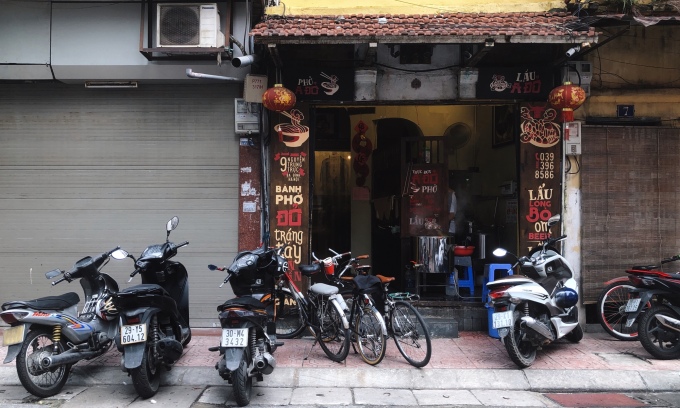
Front of A Do beef noodle shop.
Right in front of the restaurant is a pho processing counter made of wood the same color as the sign. Next to the counter is a stainless steel steamer used to directly steam pho noodles. A stainless steel bar runs across the counter to dry the newly molded pho noodles, waiting for them to cool.
Around 8am, outside, a number of motorbikes were parked in front of the restaurant, some had to park on the premises of the house next door. Inside, a female employee was continuously making pancakes on a steamer while a male employee was pouring the broth and serving it to the table. After the customers had enjoyed the pho and went to the counter to pay, the owner always asked them how they felt about the pho.
"In the early days, the pho was not as delicious as it is now," said Mr. Tuan Anh. Therefore, he often asked customers for reviews and comments, combining his personal feelings and experience to adjust the flavor. After many changes, the pho has now suited the taste of many diners and received compliments.
The techniques and principles of making rice noodles remain the same, but the ingredients have changed somewhat, said Mr. Tuan Anh. In July, he used four types of rice to make pho noodles. Now he has added a new type of rice. These five types of rice include three types of white rice and two types of red rice grown in the Xin Man region, called dragon blood rice. Red rice imported from Ha Giang is combined with two types of rice commonly used in rice rolls and pho noodles in Hanoi to retain some of the familiar flavor for diners.
The process of making pho noodles is not too complicated but takes a lot of time. 5 types of rice are mixed well, soaked for at least 6 hours and then ground with water to make the dough. The maker scoops a ladle of flour and pours it onto a thin cloth stretched over the surface of the steamer, uses the bottom of the ladle to spread the dough evenly and then covers it with a lid. After about two minutes, the pho noodles are cooked, use a wooden stick to roll the noodles up and dry them on the bar across the counter. The cooled noodles will be folded into small rectangular pieces and hand-cut into strips.
The special thing is that the rice flour used to make the cake is white but when steamed, it turns light red. The red color of the cake is the natural color of two types of Ha Giang red rice, no colorants are used, said Mr. Tuan Anh.
The restaurant uses beef imported daily from Hoai Duc (Hanoi), "a little more expensive than the average price but ensures food hygiene and is more delicious", the owner said. The beef stew dish is said by Mr. Tuan Anh to be "prepared according to his own recipe". The fresh meat is cut into small pieces, marinated with spices, including a type of aromatic leaf to create a unique aroma. The beef bones are used to make the broth, simmered for more than 22 hours with cinnamon, star anise, ginger, onions, and sea worms, like Hanoi pho broth.
To prepare a bowl of beef pho, the sliced noodles will be blanched in a separate pot of broth to separate the noodles and mix with the broth. Then add other ingredients such as beef, green onions, and pour in the broth to complete. Normally, the noodles will be rinsed and sliced in advance in a certain amount, placed in a stainless steel tray. The beef is usually only sliced after the customer orders to ensure freshness.
The dish that Mr. Tuan Anh is confident that no other restaurant in Hanoi has is mixed red pho, which consists of rice noodles mixed with sauce and lettuce, cucumber, carrots, and lightly massaged with sesame oil to soften, while beef is stir-fried with onions, bean sprouts, and garlic. On top, sprinkle peanuts, shallots, and coriander.
Because the red pho noodles are hand-made and sliced, they are thicker than regular white pho noodles and the size of each noodle is not the same. For the soup, the pho noodles blend with the broth, are chewy, do not break when picked up, have the sweetness of rice, and are richer than regular pho. The red pho noodles combined with the sweet broth of Hanoi pho create a flavor that is both familiar and new. The fresh beef is firm when chewed, while the beef stew is soft and fragrant.
Pho tron brings a different flavor thanks to the sweet and sour sauce, stir-fried beef soaked in spices, mixed with the aroma of garlic, green onions, and coriander. The herbs help reduce the fat of the beef fat released when stir-frying, while giving a fresh, crispy feeling in the mouth.
The owner slices the tenderloin into whole pieces when customers order, thus preserving the stickiness of the fresh meat. "The noodles, meat, and broth are all fragrant, delicious, and have a distinctive flavor," said Mr. Do Xuan Phuong (56 years old, Tay Ho district). He and his children have been regular customers of the restaurant since it opened.
The restaurant opens from 6am to 2pm and from 6pm to 10pm daily. Peak hours are from 8am to 10am in the morning, lunchtime (12pm - 1:30pm) and dinnertime (7pm - 8pm). On average, the restaurant sells about 60 bowls a day. The price of a bowl ranges from 45,000 to 60,000 VND. Some customers also buy pho noodles separately, but Mr. Tuan Anh only sells small quantities (2-3 noodles).
The restaurant is not very large and has little parking space. In addition, preparing a bowl of red pho takes more time than regular pho because all the steps are done by hand. To avoid long waiting times, customers should avoid coming during peak hours.
Most of the customers who come to the restaurant are locals, regulars from the beginning because "they can see the rice noodles being made directly, ensuring hygiene". Besides, there are also new customers who come to enjoy the traditional red rice noodles of the Xin Man people (Ha Giang), the restaurant owner said.
Article and photos: Quynh Mai
Source link




![[Photo] Binh Trieu 1 Bridge has been completed, raised by 1.1m, and will open to traffic at the end of November.](https://vphoto.vietnam.vn/thumb/1200x675/vietnam/resource/IMAGE/2025/10/2/a6549e2a3b5848a1ba76a1ded6141fae)





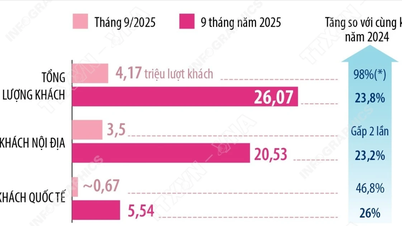







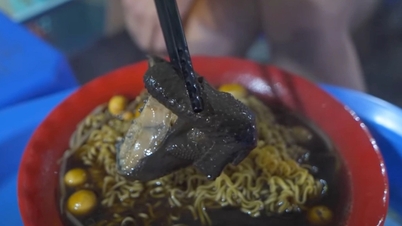





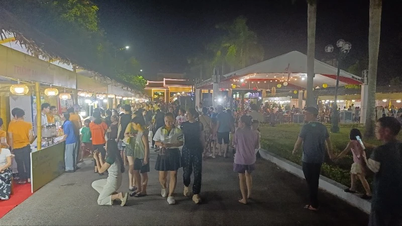



























































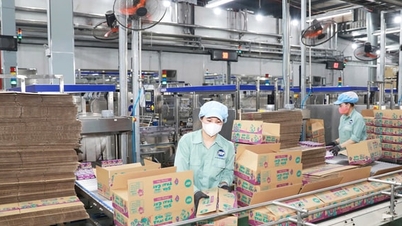

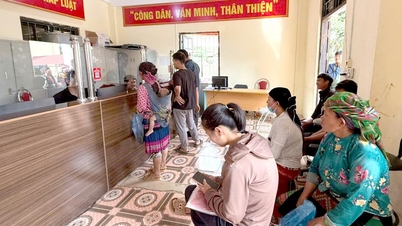















Comment (0)